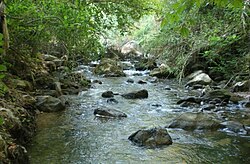Kadisha River
| Kadisha River | |
|---|---|
 The river at its upper reaches | |
 | |
| Location | |
| Country | Lebanon |
| Physical characteristics | |
| Source | |
| • location | Qurnat as Sawda', Lebanon |
| Mouth | |
• location | Mediterranean Sea |
• coordinates | 34°27′28″N 35°50′29″E / 34.4579°N 35.8415°E |
| Length | 45 km (28 mi) |
The Kadisha River or Nahr Abu Ali is a is a significant watercourse in northern Lebanon. The river that runs east to west for 45 kilometres (28 mi) originates from springs near the sacred kadisha Valley, particularly at the base of the Qurnat as Sawda' mountain, the highest peak in Lebanon. In Zgharta, in the Zgharta District the Kadisha river merges with the Rachiine and Jouit river that source from the town of Rachiine and Ehden respectively where it becomes the Abu Ali river that passes through Tripoli, Lebanon.[1][2]
The Kadisha River has played a vital role in the region’s history, providing water for agriculture and acting as a natural corridor through the rugged terrain. However, it has also faced environmental challenges, including pollution from urban and industrial activities near Tripoli. The river remains an iconic feature of northern Lebanon, symbolizing the interplay of natural and cultural heritage. Walled and partially covered on its passage through Tripoli, the river is very polluted.[2][1][3][4]

References
[edit]- ^ a b emhj. "River water pollution in Lebanon: the country's most underestimated public health challenge". World Health Organization - Regional Office for the Eastern Mediterranean. Retrieved 2025-01-28.
- ^ a b "Water Quality Assessment of Lebanese Coastal Rivers" (PDF). Archived from the original (PDF) on 2015-02-23. Retrieved 2018-01-21.
- ^ "River water pollution in Lebanon: the country's most underestimated public health challenge" (PDF). EMHJ. 2024.
- ^ "Hydrologic drought characteristics of selected basins in various climate zones of Lebanon" (PDF). Lebanese University.


 French
French Deutsch
Deutsch